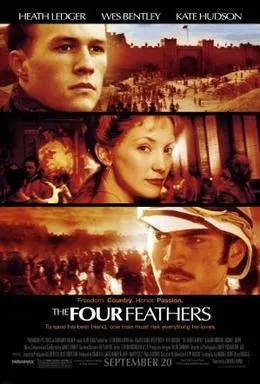Historical accuracy of The Four Feathers

Historical accuracy of The Four Feathers

Characters
Harry Faversham
Harry is the fictional protagonist of the novel. His story explores themes of courage, honor, societal pressure, and redemption against the backdrop of a real war, but he is not a historical person.
Ethne Eustace
Ethne is a fictional character representing Victorian ideals of womanhood and romance, whose actions (giving the feather) precipitate Harry's quest.
Jack Durrance
Jack is a fictional character embodying duty, steadfastness, and quiet suffering, serving as both friend and rival to Harry.
Abou Fatma
A fictional character crucial to Harry's survival and success in Sudan, representing local knowledge and acting as a guardian figure.
Lieutenant Trench
A fictional member of Harry's peer group, representing the friends whose judgment Harry seeks to overturn.
Lieutenant Willoughby
A fictional member of Harry's peer group, representing the friends whose judgment Harry seeks to overturn.
More characters
Lieutenant Castleton
A fictional member of Harry's peer group, representing the friends whose judgment Harry seeks to overturn.
Colonel Hamilton
Represents the leadership of the British regiment sent to Sudan.
General Faversham
A fictional character embodying the rigid military traditions and expectations Harry initially rebels against.
General Charles Gordon
Gordon was a real historical figure whose siege at Khartoum was a key event leading to the Gordon Relief Expedition depicted as the film's military backdrop.
The Mahdi
Muhammad Ahmad proclaimed himself the Mahdi and led the successful revolt against Egyptian-British rule depicted in the film. He is the unseen primary antagonist force.
Mahdist Warriors
Known historically as Ansar, these were the followers of the Mahdi who fought against the Egyptian/British forces, accurately depicted as determined adversaries.
British Soldiers
While individual soldiers shown are fictional, they represent the real British troops who fought and suffered in the Sudan campaign.
Story
British involvement in Mahdist War / Gordon Relief context
The film is accurately set during the British intervention in Sudan (Mahdist War), specifically around the time of the expedition sent to relieve General Gordon at Khartoum (1884-85).
Victorian military society's code of honor
Effectively portrays the intense social pressure and emphasis on military duty, courage, and fear of disgrace prevalent among the British officer class in the late Victorian era.
Harry Faversham resigns commission before deployment
Harry Faversham and his resignation are fictional elements from the novel, driving the central plot.
Receiving four white feathers for cowardice
The giving of white feathers (a symbol of cowardice originating later, popularized by the novel) to the fictional Harry by his friends and fiancée is central to the novel's plot, not a historical event.
Harry travels to Sudan in disguise to redeem honor
Harry's entire journey to Sudan, his disguises, and his specific mission to save his friends are fictional plot points from the novel.
Depiction of harsh desert conditions in Sudan
The film accurately portrays the extreme heat, difficult terrain, and dangers of the Sudanese desert environment faced by the historical campaign.
Mahdist forces depicted as formidable
The Mahdi's Ansar forces were known for their religious fervor, large numbers, and fierce charges, inflicting heavy casualties on Egyptian and British forces in several battles.
Depiction of major battle (Abu Klea / British square broken)
The film depicts a chaotic battle resembling Abu Klea (Jan 1885). British squares did come under intense attack; whether one was definitively "broken" is debated, but they faced severe pressure as shown.
Harry saves Jack Durrance (blinded)
Jack Durrance is fictional, as is his blinding and rescue by Harry. This is a key element of the novel's plot demonstrating Harry's redemption.
Harry saves Castleton
Castleton is fictional, and his specific predicament and rescue by Harry are part of the novel's narrative structure of redemption.
Harry saves Trench from prison (Omdurman)
Trench is fictional. While some Europeans were held prisoner by the Mahdists (e.g., after Khartoum fell), Harry's infiltration and rescue mission are fictional.
Use of disguise / Help from Abou Fatma
Harry's ability to survive and operate relies on the fictional Abou Fatma and disguises central to the novel's adventure plot.
Harry's honor redeemed / Reconciliation
The entire arc of redemption by returning the feathers through acts of bravery, leading to social and romantic reconciliation, is the fictional resolution of the novel.
Setting
Victorian England (upper class / military settings)
The film effectively recreates the atmosphere, architecture, and social milieu of upper-class Victorian Britain, particularly its military circles.
Sudan landscapes (desert, Nile)
Filmed in Morocco and England, the locations convincingly represent the harsh desert environments, river settings, and sparse vegetation typical of the regions where the Sudan campaign took place.
British military uniforms (Red Coats / Khaki)
Accurately shows the transition in uniforms: the traditional red coats still used in some engagements early on, and the more practical khaki uniforms adopted for desert warfare.
British weaponry (Martini-Henry rifle, Gatling gun)
Depicts standard British equipment of the era, including the single-shot Martini-Henry rifle, revolvers, artillery, and early machine guns (like the Gardner or Gatling gun).
Mahdist warriors' appearance (jibbehs) & weapons
Shows the Ansar fighters wearing their distinctive patched robes (jibbeh) and wielding traditional weapons like swords and spears, alongside captured firearms.
British infantry square formation
Accurately depicts the use of the infantry square, a key British tactic for defence against cavalry or massed infantry charges common in colonial warfare during this period.
Late 19th Century colonial conflict atmosphere
Captures the sense of British imperial confidence mixed with the dangers and cultural clashes inherent in colonial campaigns against determined local resistance.
Depiction of Omdurman prison conditions
If depicting the prison (where Trench is held), it portrays harsh conditions based on accounts of Mahdist captivity, though specific details serve the fictional plot.
Ports / Towns (Suakin, Cairo implied)
Provides glimpses of the ports and staging areas used during the Sudan campaign, reflecting the logistical aspects of the historical expedition.
